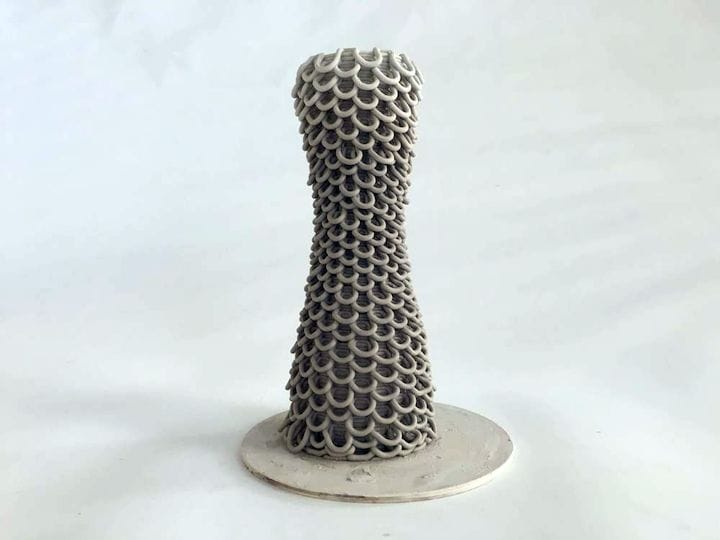![A delicate and complex 3D clay print made with the PotterBot [Source: DeltaBots]](https://fabbaloo.com/wp-content/uploads/2020/05/image-asset_img_5eb0a8dcbb93d.jpg)
Since we last looked at the PotterBot two years ago, it seems there have been many improvements.
DeltaBots is a Florida-based company that produces 3D printers that specialize in clay printing, hence the name of their main product line, the PotterBot.
3D printed clay is not a new thing; it’s been done for at least a decade, but there have been many challenges. The typical setup for 3D printing clay has been to simply replace the thermoplastic extruder on an otherwise normal 3D printer with a syringe mechanism loaded with clay.
But it’s not really clay; it usually is a wet mix of water and clay that enables the material to move freely through the syringe nozzle. While this approach does work, it has a significant drawback: the wet clay is not particularly structurally sound.
In other words, prints are rather slumpy, cannot handle otherwise normal overhangs, and are usually unable to achieve any significant height due to structural collapse. Wet clay just isn’t a great print material.
![An unusual 3D clay print made by PotterBot [Source: DeltaBots]](https://fabbaloo.com/wp-content/uploads/2020/05/potterbot-wiggly_result_img_5eb0a8dd3091d.jpg)
Another annoyance with conventional clay printer designs is the requirement for an external air compressor to drive the syringe. The compressor, in addition to being a separate unit, also can be quite noisy and make the combined apparatus unsuitable for use in many situations.
These problems seem to have been overcome with the PotterBot 7 series.
First, these machines do not use a compressor to drive the extruder. Instead they use a mechanical screw system. This is not only powerful, but also near-silent.
Secondly, this powerful screw mechanism is sufficiently strong to drive not just wet clay, but “actual” clay! This leads to a number of advantages that overcome many of the constraints of conventional 3D clay printer design.
![A large wall made from complex 3D printed clay tiles [Source: DeltaBots]](https://fabbaloo.com/wp-content/uploads/2020/05/image-asset_img_5eb0a8dd8c387.jpg)
You can 3D print taller structures with the PotterBots due to increased material strength. Because the clay is stronger you do not need to pause the print to allow for lower levels to air dry to grow their strength. Here you simply keep 3D printing as you would want to do. DeltaBots says you can 3D print clay objects as tall as 1.2m, with widths up to 660m. That’s plenty large for almost any conceivable clay project.
The PotterBots can handle some overhang amounts, although it’s still nowhere near what some thermoplastic machines can deal with.
The added material strength even allows the printer to successfully stop and start without material leaking. This is not easily done with air compressor systems as air itself contracts and expands in the plumbing to the syringe. PotterBots can even reverse the flow to perform a kind of “retraction” action.
It seems that DeltaBots also spends effort on the material itself. Evidently in other systems you often end up with air bubbles captured in the syringe, which, guess what, are extruded and appear as gaps in your print. DeltaBots prepares their material in a special air extraction system to ensure there are no bubbles nor gaps.
An important feature is the ability to easily swap nozzles. This is particularly important for slow clay printing, where a larger-size nozzle can quickly speed up printing. DeltaBots offers a selection of up to a massive 16mm diameter, one of the largest 3D printing nozzles we’ve heard of.
Currently the company offers eight different machine configurations, with build volumes ranging from 250mm to over a meter, with prices going from US$2,850 to almost US$15,000.
Clay 3D printing is not for everyone, but for those interested in producing large, complex ceramic objects, the PotterBot could be something to look at very closely.
Via DeltaBots











